Packaging industry researchers are warning of a global shortage of paper and increased prices in the face of rising demand. NOA-PRISM has investigated global trends and predicts more price increases.
Neil Osment, Managing Director of NOA-PRISM, said the industry had hit a perfect storm of increased demand – fuelled by the growth of ecommerce, even more formats of shelf ready packaging, and the public’s backlash against plastic – and a shortage of supply.
“UK buyers have had three price rises in corrugated over the last 12 months and it looks like a fourth increase is likely during this first quarter of 2018,” says Osment. “This trend may continue until UK prices are in line with those in Europe and until Europe’s prices are in line with those of other global markets.”
Demand for paper began outstripping supply last year in the US, where the need for corrugated packaging has grown by 2% year on year for the last three years, with no comparable increase in supply for kraft paper liners and few plans for investing in more kraft paper production.
Global demand for corrugated has also seen a huge upsurge, growing on average at 3.3% per year from 200 billion square meters (bsm) in 2011 to almost 236 bsm in 2016. NOA-PRISM’s packaging industry analysis forecasts future growth at an average of 3% for the next five years, resulting in a global market of 273 bsm by 2021. That projected growth of 37 bsm is nearly equivalent to the size of the US corrugated market today.
Osment adds, “There is some capacity left in the US market by bringing mothballed fine and graphic paper mills back into production, but not enough of the right type of production capacity in North American mills to meet today’s demands, let alone the next few years.
“The situation has also been aggravated by a shortage of good quality old corrugated waste, but this shortage at least is beginning to ease. Our packaging industry research shows that brand owners are now beginning to look at alternatives to corrugated packaging and this might end up being the way forward over the next few years; it’s a challenge to predict.”
To get in touch email [email protected]








